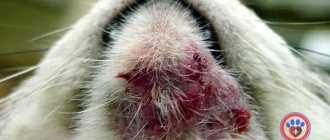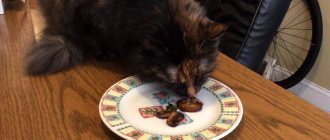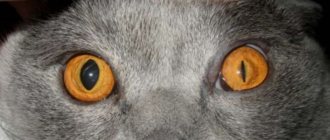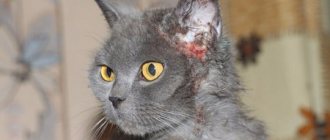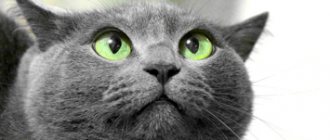A spacer for cats is necessary for the treatment of respiratory diseases. With its help, medications enter directly into the lungs, easing the condition of the furry patient. Devices can be selected taking into account the size of the cat; the most popular models are AeroKat, TD VET, SniffUp.
The price of the device can reach 6,000 rubles. The simplest inhaler can be made independently from a plastic bottle.
Indications for use
An inhaler for cats is used in the following situations:
- Bronchial asthma. The disease is characterized by difficulty breathing and cough. The basis of therapy is glucocorticosteroids in the form of inhalations.
- Chronic bronchitis, pneumonia, laryngitis. The delivery of anti-inflammatory drugs directly to the respiratory organs greatly facilitates the pet’s condition.
- Respiratory allergies. Inhalation with antihistamines helps relieve an attack of shortness of breath.
Using a spacer.
[custom_ads_shortcode2]
Preventing asthma
Basic preventive rules in order not to provoke attacks:
- maintaining hygiene in the apartment where the pet lives;
- daily wet cleaning of the premises;
- using an air purifier;
- In summer, during the growing season of plants, open windows less frequently to prevent allergens from entering the air;
- proper pet nutrition, balance, hypoallergenicity. Do not use products that cause food allergies: lactic acid, chicken, lamb, corn;
- hygiene and care for the pet itself, the use of hypoallergenic cosmetics, treatment for parasites.
Thus, there is no 100% effective treatment for feline asthma. The manifestation of the attacks themselves can be significantly alleviated or stopped with the use of special medications. In any case, you cannot do without consulting a veterinarian. The approach to treatment should always be individual. The use of preventive measures helps reduce the number of attacks or significantly ease their course.
Contraindications
You should not use a spacer for cats if:
- the animal is suffering from an infectious disease;
- there are skin lesions around the nose and on the muzzle;
- the cat has heart problems;
- diagnosed with diabetes.
We recommend reading about the treatment of bronchitis in cats. From the article you will learn about the causes of bronchitis in cats, symptoms and diagnosis in pets, and treatment with antibiotics. And here is more information about why a cat coughs, as if it was choking.
[custom_ads_shortcode3]
What should an inhaler for cats be like?
An inhaler for cats should consist of two parts - a cylinder in which the aerosol is formed, and a mask. The volume of the cylinder is usually 150-200 ml. The animal mask has an inhalation and exhalation valve.
Only in this case can it be ensured that aerosol particles enter the pet’s respiratory tract. The mask is made of soft silicone material. Since cats breathe through their nose, it should fit snugly against the animal's face.
For cats and small breeds of dogs, special veterinary inhalers of such brands as AeroKat, TD VET, and SniffUp are used.
The MED2000 compressor nebulizer, designed for children, is also suitable for administering medications through inhalation. In this device, the direction of the medicinal aerosol can be adjusted, the compressor provides air flow, which allows the drug to reach even the most remote areas of the bronchi and provide a long-lasting therapeutic effect.
[custom_ads_shortcode1]
Diagnosis of asthma
Tip: The larvae of some types of worms live in the lungs for some time. There are also separate types of helminths - pulmonary ones. Therefore, if a cat develops a cough in the absence of other symptoms, it is necessary first of all to deworm the pet, preferably with a drug that affects different stages of parasite development. Read more about lungworms here
Asthma should then be separated from diseases such as dirofilariasis (an infestation caused by worms that parasitize the heart and pulmonary artery), upper respiratory tract infections, heart failure, pulmonary edema, pulmonary thromboembolism, pleural diseases, neoplasms in the bronchi and lungs, foreign bodies in respiratory tract, pneumonia, bronchitis, etc.
Examination between attacks may not detect pathology.
Unfortunately, there are no simple laboratory tests that can diagnose feline asthma with 100% certainty. The most indicative are a chest x-ray and a general blood test.
X-rays can reveal thickening of the bronchial walls - the most important factor in asthma, stretching of the diaphragm. This study helps confirm or exclude other diseases (heart failure, pneumonia, neoplasms, foreign body, etc.). Although sometimes radiography in asthmatic cats may not show pathologies.
A complete blood count reveals eosinophilia, characteristic of asthma - an increase in the number of eosinophils. Although, again, their normal amount does not exclude the disease.
If asthma is suspected, additional tests are sometimes carried out, for example, cultures from tracheobronchial swabs, and stool analysis for parasites.
How to use an inhalation spacer for cats
The inhalation spacer for cats is used as follows:
- The animal must be accustomed to the device. Let him smell it.
- Connect the balloon and mask together.
- Press the mask tightly to the animal's face. You should act gently.
- Press the aerosol container.
- Hold the mask on the cat's face for 10-15 seconds.
- If the device is equipped with an inhalation indicator, make sure that it vibrates.
- This action allows one dose of the drug to be administered into the animal’s respiratory tract. If more is prescribed, then the manipulation is repeated.
A break should be taken between the administration of the first and second dose of the medication. The cat needs to be calmed and caressed. Watch this video on how to inhale a cat using a spacer:
[custom_ads_shortcode2]
AeroKet spacer for cats (AeroKat)
The AeroCat spacer for cats is a modern and safe inhaler specially designed for animals. The device includes a dosing bottle and a mask. The device is equipped with an indicator that makes it easy to count the number of breaths the animal takes.
Feature of the mask
The mask in the AeroCat spacer is made of soft silicone material and is available in two sizes – 3.2 and 3.9 cm. This allows you to select the device to suit the size of your pet. The mask should be selected so that it covers the cat's nose and mouth, but does not come into contact with the eyes.
Spacer AeroKat
How to care for your asthma device
Proper care of the asthma device comes down to the following manipulations:
- After use, the balloon must be disconnected from the mask and any remaining medication must be removed.
- Rinse the container thoroughly with warm water, rinse with boiled water and dry.
- Wash the silicone mask with running warm water and soap and dry.
- The device should be stored in a box in a dark and dry place.
[custom_ads_shortcode3]
Inhaler for cats for asthma
Asthma: 12 ways to breathe easier
Asthma in cats. Quite recently, the only thing faster than your cat was a rare fly that happily escaped reprisals. And now, as soon as she plays outside for a little while, the puffing and coughing begins, and the poor thing just collapses from fatigue. These are signs of asthma. Dr. Lizardo Martinez, who has a private practice in Miami, explains that asthma in cats is usually triggered by dust and pollen; At the same time, the airways become inflamed and narrowed, so that air passes through them with difficulty. Dogs suffer from this disease less frequently. Of course, a sick animal cannot do without medications, but even without them there are ways to make breathing easier. Only for cats
Slimness will decorate any cat, but with bronchial asthma it is simply necessary. In overweight animals, the disease is more severe. A gradual reduction in the daily diet and the correct selection of food will help you lose weight. Discuss diet with your veterinarian.
Dry air irritates the airways, triggering asthma attacks. When using an air conditioner indoors, the relative humidity sometimes does not exceed 10%. In winter, heaters also dry out the air. To soften the air, Dr. Janet Childs, who has a private veterinary practice in Fairview, Tennessee, advises installing a humidifier in the house and using it to maintain relative humidity at 30-40%. It is not necessary to go higher, otherwise mold and house dust mites will grow in the house, which also cause asthmatic attacks.
Tobacco smoke worsens the condition of a patient with asthma. As Dr. Carol Machery, who has a private practice in Nashville, notes, the concentration of nicotine at the floor level is higher, so the animal gets more harmful substances. If you smoke, quit for the sake of your cat’s health (and yours, too). Or at least don't smoke in the house.
If asthmatic attacks are caused by pollen allergens, then during the flowering season it is better not to let the animal go outside, especially in the mornings and evenings, when the concentration of pollen in the air is highest.
Most cat litter generates dust when your cat digs into it. Buy dust-free litter or put wet sand in the cat's litter box.
Many commonly used household chemicals - hairspray, deodorants, detergents and other substances - provoke asthma attacks. Try to protect your pet from their influence. Whenever possible, use mild cleaners (vinegar, baking soda), advises Dr. Jeffrey Fineman, who has a private veterinary practice in Weston, Connecticut. Cleaning bathrooms and other areas where mold grows still requires chlorine solutions. Be sure to rinse them well with clean water. It is better to take the animal to another room while cleaning until the smell dissipates.
An asthma attack can be triggered by the slightest air pollution. Therefore, the areas where your cat walks should be kept as clean as possible. Don't forget to move the furniture so that there is no dust left there. When you notice, move the animal away until all the dust settles.
In mattresses, bedding, and upholstered furniture, where dust accumulates, microscopic mites live, which cause an allergic reaction and asthma attacks. We recommend covering mattresses and pillows with vinyl covers. Once a week, the animal's bedding should be washed with hot water and soap. The fewer ticks in the house, the easier it is for your pet to breathe.
In homes with central heating and ventilation, it is useful to install electrostatic filters to clean the air.
Look for triggers
If your pet's asthma is new, it may be due to some new additions to your home, such as a new rug or couch. Cats sometimes react even to new shampoo or washing powder. Go back to the previous brands and see if it doesn't improve
source
Nebulizer instead of a device: is it worth using?
In the absence of a spacer, a nebulizer can be used to relieve an acute attack of asthma, but the device has a number of disadvantages for use in animals:
- high price;
- duration of the procedure (5-15 minutes);
- the mask does not match the size of the muzzle;
- The device operates from the electrical network.
That is, you can use it, but it is difficult to hold the cat and carry out the inhalation correctly.
[custom_ads_shortcode2]
How to make a spacer yourself from a plastic bottle
You can make a spacer yourself from a plastic bottle; for this purpose, you should take a 0.5 liter plastic bottle and cut off the bottom. The prescribed medicine must be placed in the neck of the improvised inhaler. The wide side should be facing the muzzle. The disadvantage of this design is its rough appearance and hard materials, making it difficult to count breaths.
We recommend reading about pneumonia in cats. From the article you will learn about animals at risk for this disease, classification of pneumonia, symptoms, diagnosis and treatment. And here is more information about how to treat lichen in a cat.
A cat spacer is an effective and safe device for delivering medications directly into your pet's lungs. With the help of inhaled administration of drugs in animals, acute attacks of bronchial asthma, allergic rhinitis are stopped, pneumonia and bronchitis are treated. A ready-made spacer can be purchased taking into account the size of the animal or made independently from a plastic bottle.
[custom_ads_shortcode3]
Useful video
Watch this video on how to make a spacer at home:
Abstract.
- Inhaler with spacer - an alternative to a nebulizer
- The spacer must meet certain requirements
- When inhaling, press the mask firmly against the animal's face.
- No need to inhale for more than 10 seconds
- For one inhalation - only one “spray”
- It is advisable to take a short break between doses.
Like people, animals often suffer from respiratory allergies, the sad but logical continuation of which is bronchial asthma. The simplest and most effective way to treat this disease is to deliver the drug in the form of an aerosol directly to the affected organ, i.e. into the animal's lungs. For this, two methods are used: • nebulizers (devices that in one way or another convert a liquid medicine into an aerosol); • metered-dose aerosol inhalers (MDI, canisters - “pshikalki”). The first method is certainly good and effective, but requires the purchase of an expensive device and a long time (5-15 minutes) of inhalation. In addition, most nebulizers operate from an electrical network, which is not always convenient or possible. The second method, with a certain skill, is simpler, cheaper, more convenient and no less effective. But, it also requires an additional device - a nozzle on the MDI - a spacer. In this article we will not consider the technique of inhaling animals using a nebulizer.
Treatment of asthma in cats using a MDI in conjunction with a spacer is a completely effective alternative to nebulizer therapy. Of course, if the procedure is carried out correctly using the “correct” spacer.
[custom_ads_shortcode1]
Asthma symptoms
Symptoms of feline asthma can appear suddenly and can be quite dangerous and scary to watch. Just like an asthmatic person who feels like he can't breathe, a cat may become terrified and panic. Therefore, you should do everything in your power to calm your cat when she is having trouble breathing. Do not under any circumstances put psychological pressure on her at this time: do not catch the cat and put it in a carrying container. First, let her calm down and come to her senses.
One of the main symptoms of asthma is frequent whistling exhalations.
If this is the first time your cat has had trouble breathing, take her to the veterinarian or emergency clinic immediately (if it happens during the evening hours, weekends, or holidays). Be sure to call so that the clinic is ready for your arrival, and prepare yourself for a long, anxious wait while veterinarians look for the cause of your cat's breathing problems. Determining asthma in a cat is not so difficult: cats are active animals and love to play. Due to breathing problems, the cat will not be able to withstand playing for a long time, and it is at the moment of fatigue that the main symptom of asthma appears, which is described in the highlighted fragment above.
What should a cat spacer be like?
- The volume of the spacer should be from 150 to 200 ml.
In a spacer of a smaller volume, the dose of aerosol from the MDI can will not be evenly distributed throughout the entire volume, because a fair portion of the aerosol will inevitably fall on the walls of the device. The volume of the spacer should not be too large; the animal should “consume” the entire volume in about 10 seconds. The aerosol cannot remain in suspension forever; after a short time (about 10 seconds) it will begin to settle on the walls of the device; - The spacer must have a mask
, without which inhalation is impossible. There is no point in inserting the mouthpiece of the spacer directly into the animal's mouth, because... cats breathe through their nose. It is also ineffective to hold the mouthpiece near the cat's nose, because... in this case, the animal will not breathe the drug from the spacer, but air from the room; - It is desirable that the mask has an exhalation valve
, which will facilitate the exhalation process and eliminate the “suffocation” effect when inhaling an animal; - The spacer must have an inhalation valve
that prevents air from entering the spacer when the animal exhales, which would lead to sedimentation of the drug on the walls; - The mask should be soft silicone
, allowing you to press it tightly, without gaps, to the animal’s face.
The Free-breath Baby Flow spacer with a mask for babies meets all these requirements. The spacer is intended for inhalation of children from birth to 3 years old, but is also successfully used for inhalation of pets. Spacer volume 175 ml.
Before inhalation, we recommend that you “practice” without the drug. The goal is to determine the sufficient force of pressing the mask to the animal’s face and to allow the cat to get used to the unfamiliar object. For this:
- attach the mask to the spacer;
- cover the hole for connecting the MDI with your palm;
- briefly press the spacer mask firmly against the animal’s face;
- Make sure the inhalation indicator deflects or vibrates slightly as the animal breathes;
- remove the spacer from the animal.
ATTENTION! This procedure is necessary solely to practice the pressing force of the mask. At this time, the animal’s breathing is extremely difficult, do not do this for more than a few seconds!
During inhalation with an inhaler (MDI) attached to the spacer, animals do not experience any difficulties
. Inhalation should be carried out for about 10 seconds.
- Remove the protective cap from the spacer mouthpiece;
- Attach the mask to the spacer;
- Attach a metered dose aerosol inhaler to the spacer;
- Gently but firmly press the mask onto the animal's face;
- Briefly press the inhaler canister, one dose of the aerosol will be injected into the spacer flask;
- Hold the mask near the animal's face for about 10 seconds;
- If you are prescribed more than one dose at a time, repeat the previous two steps;
- You can take a short break between doses to allow the animal to calm down a little.
Abstract.
- Inhaler with spacer - an alternative to a nebulizer
- The spacer must meet certain requirements
- When inhaling, press the mask firmly against the animal's face.
- No need to inhale for more than 10 seconds
- For one inhalation - only one “spray”
- It is advisable to take a short break between doses.
Like people, animals often suffer from respiratory allergies, the sad but logical continuation of which is bronchial asthma. The simplest and most effective way to treat this disease is to deliver the drug in the form of an aerosol directly to the affected organ, i.e. into the animal's lungs. For this, two methods are used: • nebulizers (devices that in one way or another convert a liquid medicine into an aerosol); • metered-dose aerosol inhalers (MDI, canisters - “pshikalki”). The first method is certainly good and effective, but requires the purchase of an expensive device and a long time (5-15 minutes) of inhalation. In addition, most nebulizers operate from an electrical network, which is not always convenient or possible. The second method, with a certain skill, is simpler, cheaper, more convenient and no less effective. But, it also requires an additional device - a nozzle on the MDI - a spacer. In this article we will not consider the technique of inhaling animals using a nebulizer.
Treatment of asthma in cats using a MDI in conjunction with a spacer is a completely effective alternative to nebulizer therapy. Of course, if the procedure is carried out correctly using the “correct” spacer.
[custom_ads_shortcode2]
Experience in the treatment of bronchial asthma in cats using the Aeroket spacer.
I'll tell you about my experience: After waiting for the cat to start coughing, we started inhalations, this was 11/18/12. We tried to do them once a day, that is, one “spray” of flixotide 125 mg, and the cat takes 15-25 breaths (there is a breath indicator on the spacer). During all this time, the cat has not had a single episode of coughing (for two months now, pah-pah-pah, of course). Honestly, Kota really doesn’t like these procedures; by nature he is a big coward, but... I put his butt towards me so that he has nowhere to back away, I put my left hand on his back, and with my right I press the mask to his muzzle. There are many videos on this subject on the Internet, this one
, for example, or
this one
.
You can order a spacer here
, it costs 70 dollars, together with delivery it will cost 4 thousand rubles. with a tail, delivery is expensive, it’s better, of course, to cooperate with someone.
Dear moderators! Please do not remove links from the text, because... The topic was PINCHED with THESE links!
some important links that cannot be posted in any other format Dear moderators! These links cannot be deleted from a PICKED topic.
Dear owners of asthmatic cats!
Please write about your problems in this topic, because other users are very interested in your experience!
Have you purchased Aeroket? Flixotide 250 is too much, use Flixotide 125 twice a day if you have a daily cough. Read carefully the 2nd post in the topic:
If the cough is daily or almost daily, but in general the cat feels well, the dosage of inhaled GCS is 125 mcg of Flixotide twice a day. When an attack develops, Salbutamol is added. In case of significant improvement in the condition up to the complete disappearance of cough within 2 months of using Flisotide, the dose may be reduced to 125 mcg of Flisotide once a day. If the cough is daily or almost daily and has an impact on the cat's quality of life (i.e., if the cat gets tired easily, wakes up from coughing, periodically breathes with effort), the dosage is 125 mcg Flixotide twice a day, plus prednisolone 1 mg/day. kg twice a day for 5 days, followed by a gradual reduction in dose until discontinuation.
I apologize for such information, but maybe someone needs it. I ordered an Aeroket spacer on an American website, but didn’t immediately realize that it already contained masks, so I ordered an extra medium mask.
If someone needs it, keep in mind, I will give it away cheaply. I just don't need her.
Hello! Can I ask a slightly off-topic question, but about asthma?
Our cat has asthma. For 5 years now we have been feeding him only Royal Canin hypoallergenic (dry) and Eukanuba Dermatosis (canned). But at the moment, Eukanuba has disappeared from sale everywhere, and even the representative office reported that, temporarily, the plant has stopped producing all Eukanuba canned food. Please tell me what kind of wet food can be replaced without harming the cat (they tried z/d - it seemed that the cat was coughing because of it - they refused) is there any other food with a similar composition? What do you feed cats with asthma?
Hello! I want to share my experience) My cat was diagnosed with asthma when he was six months old, then he almost died, because I had no idea about asthma then, I took him to the doctor when he was already breathing heavily. Survived, thank God. Now he is three years old. He was treated mainly with dexamethasone injections; then he had attacks about once a month. Then we moved, renovations, dust, stress - the attacks became more frequent, they prescribed pills - first dexazone, then pronizone. A year ago there was a very serious attack, the cat almost died again - we left for literally a day, nothing foreshadowed, as they say, but when we returned - he was lying like a rag. They immediately took me to the clinic. Veterinarians pumped him out for almost four hours. After that I ordered the Aeroket spacer. The problem is that our veterinarians encountered such a case for the first time; I myself printed out the American treatment regimen for them so that they could determine the dose. They prescribed flixotide 110 mcg 2 times a day and ventolin as needed, plus 5 mg of pronisone was left every day. The condition was relatively stable, but seizures still occurred. The problem is that it was almost impossible to stop taking the pills. Veterinarians advised starting to give pills every other day, then two, three, and so on, until complete withdrawal. This did not help, the attacks immediately became more frequent, and I had to return to the usual pattern again. There was no improvement. I realized that this cannot continue, because... Constantly taking corticosteroids is too much of a burden on the cat’s body, and I bought a spacer precisely to make his life easier. It turns out that everything is in vain. There was no point in going to the doctors; they couldn’t advise me anything new. I started reading articles about the treatment of asthma in cats, consulted with people who have asthmatic children to understand the principle of treatment, and read about how to stop corticosteroids. As a result, I decided to stop taking the pills according to my own scheme and give the cat vitamins C and E to start the process of producing its own hormones. It turns out that the lower the dose of corticosteroids taken, the slower they need to be discontinued. It is not surprising that the scheme “give every other day, then every other day, etc.” didn't work. According to my regimen, within a month and a half, I was able to reduce the dose of pronisone from 5 mg to 1 mg per day, while giving vitamins C and E. During the entire month and a half, the cat had ONE minor coughing attack, and that was due to stress. I buy the most common vitamin C, I give it somewhere around 30-50 mg per day. Vitamin E in capsules, the smallest dosage (like 100). Flixotide inhalations 2 times a day, the dosage is about 360 mcg per day, but I will also gradually reduce it. I used Ventolin once during that lonely attack and a couple more times for prevention - because... We had the parquet floor varnished in one room, and no matter how much we ventilated, the smell was still there. But the cat did not have any reaction to this varnish (also surprising). In general, I’m as happy as an elephant) My cat is flexible and has nothing against the spacer) Sometimes he pushes him away with his paws, but I win) One asthmatic friend said that after inhaling flixotide people are advised to rinse their mouths with water to avoid cavity candidiasis mouth Therefore, after inhalation, I always give the cat a special sauce for cats as a reward) I still need to put him on a diet, but this is the most difficult thing!)
I hope this writing will be useful to someone)
PS Food - Royal Canin for sterilized cats, filler - clumping wood "Cats Best". Factors that caused attacks to occur or become more frequent - drying clothes in the apartment (now I dry them on the balcony), hairspray (I don’t use it anymore), insect spray (I don’t use it anymore because the attacks are very strong), air freshener (now I use a spray with essential oils). Just in case, I use washing powder for children. Yes, I also forbid everyone to smoke here! We ourselves do not smoke, but some guests smoke, this is Serbia, the majority are like that here, but I send them to the balcony)))
Only registered users have the ability to start new topics. Register and log in to the site by entering your username and password on the right side of the window, and you can start a new topic.
Before visiting the forum, read the topic: “How to properly consult a veterinarian,” as well as the list of answers to frequently asked questions, this will help you save your time and get an answer to your question faster. Pay special attention to the document: Symptoms of animal diseases. Perhaps in your situation you cannot expect an answer on the forum, but you need to urgently call a doctor or take the animal to a veterinary clinic!
What should a cat spacer be like?
- The volume of the spacer should be from 150 to 200 ml.
In a spacer of a smaller volume, the dose of aerosol from the MDI can will not be evenly distributed throughout the entire volume, because a fair portion of the aerosol will inevitably fall on the walls of the device. The volume of the spacer should not be too large; the animal should “consume” the entire volume in about 10 seconds. The aerosol cannot remain in suspension forever; after a short time (about 10 seconds) it will begin to settle on the walls of the device; - The spacer must have a mask
, without which inhalation is impossible. There is no point in inserting the mouthpiece of the spacer directly into the animal's mouth, because... cats breathe through their nose. It is also ineffective to hold the mouthpiece near the cat's nose, because... in this case, the animal will not breathe the drug from the spacer, but air from the room; - It is desirable that the mask has an exhalation valve
, which will facilitate the exhalation process and eliminate the “suffocation” effect when inhaling an animal; - The spacer must have an inhalation valve
that prevents air from entering the spacer when the animal exhales, which would lead to sedimentation of the drug on the walls; - The mask should be soft silicone
, allowing you to press it tightly, without gaps, to the animal’s face.
The Free-breath Baby Flow spacer with a mask for babies meets all these requirements. The spacer is intended for inhalation of children from birth to 3 years old, but is also successfully used for inhalation of pets. Spacer volume 175 ml.
Before inhalation, we recommend that you “practice” without the drug. The goal is to determine the sufficient force of pressing the mask to the animal’s face and to allow the cat to get used to the unfamiliar object. For this:
- attach the mask to the spacer;
- cover the hole for connecting the MDI with your palm;
- briefly press the spacer mask firmly against the animal’s face;
- Make sure the inhalation indicator deflects or vibrates slightly as the animal breathes;
- remove the spacer from the animal.
ATTENTION! This procedure is necessary solely to practice the pressing force of the mask. At this time, the animal’s breathing is extremely difficult, do not do this for more than a few seconds!
During inhalation with an inhaler (MDI) attached to the spacer, animals do not experience any difficulties
. Inhalation should be carried out for about 10 seconds.
- Remove the protective cap from the spacer mouthpiece;
- Attach the mask to the spacer;
- Attach a metered dose aerosol inhaler to the spacer;
- Gently but firmly press the mask onto the animal's face;
- Briefly press the inhaler canister, one dose of the aerosol will be injected into the spacer flask;
- Hold the mask near the animal's face for about 10 seconds;
- If you are prescribed more than one dose at a time, repeat the previous two steps;
- You can take a short break between doses to allow the animal to calm down a little.
Treating cats for asthma and chronic bronchitis is often done with anti-inflammatory drugs (steroids) combined with bronchodilators (which make breathing easier). Traditionally, these medications are given to cats via swarms, tablets or drops, and injections.
However, to treat people for these same diseases, medications are most often delivered to the lungs using inhalers. Cats can also be treated using the same method; special dispenser inhalers have been developed for them. With their use, medication is delivered to the lungs simultaneously with the cat inhaling air.
Inhalers cannot be used on cats, so a special device called a spacer . Exactly the same devices are used when conducting inhalation therapy for children. The required dose of medication is supplied to the spacer chamber, and then the cat inhales air (and the drug) from the chamber using a face mask mounted on it.
Some adapted models of children's spacers can be used for cats. This is a possible but not optimal solution. In particular, some have valves that make it difficult for a cat to inhale medication from the chamber, and it is often difficult to find the appropriate spacer mask to fit the shape and size of a person's face.
There are spacers designed specifically for cats (eg Aerokat - www.aerokat.com) that are easy to use and come with a small mask to fit the cat's face. If the device is properly cared for, it can be used for many years.
[custom_ads_shortcode3]
Using Inhalers to Treat Cats for Asthma
Treating cats for asthma and chronic bronchitis is often done with anti-inflammatory drugs (steroids) combined with bronchodilators (which make breathing easier).
Traditionally, these medications are given to cats via swarms, tablets or drops, and injections. However, to treat people for these same diseases, medications are most often delivered to the lungs using inhalers. Cats can also be treated using the same method; special dispenser inhalers have been developed for them. With their use, medication is delivered to the lungs simultaneously with the cat inhaling air.
Inhalers cannot be used on cats, so a special device called a spacer . Exactly the same devices are used when conducting inhalation therapy for children. The required dose of medication is supplied to the spacer chamber, and then the cat inhales air (and the drug) from the chamber using a face mask mounted on it.
Some adapted models of children's spacers can be used for cats. This is a possible but not optimal solution. In particular, some have valves that make it difficult for a cat to inhale medication from the chamber, and it is often difficult to find the appropriate spacer mask to fit the shape and size of a person's face.
There are spacers designed specifically for cats (eg Aerokat - www.aerokat.com) that are easy to use and come with a small mask to fit the cat's face. If the device is properly cared for, it can be used for many years.
Preparing a cat for treatment using a spacer
Before you start using a spacer to administer medications into a cat's lungs, it is advisable to accustom the cat to the mask by simply putting it on, without injecting medications into the chamber. Gradually accustom your cat, try to do it calmly and cheerfully - by playing and spending time with the cat. Ideally, the cat will get used to the mask and no problems will arise during the treatment process.
At first, you only need to put the mask on the cat’s face for 2-3 seconds, then the time gradually increases to 20-30 seconds. Once your cat gets used to the mask, try connecting the camera briefly and repeat the process until your cat gets used to it and learns to breathe calmly through the camera device. Once your cat stops fussing when the spacer is placed on her, you can begin using medications.
[custom_ads_shortcode1]
Preparation and instructions for use
For cats, special veterinary inhalers AeroKat, TD VET, and SniffUp are used. The MED2000 pediatric compressor nebulizer is also suitable because the direction of the medicinal aerosol can be adjusted so that it hits only the throat, lungs or bronchi. The compressor provides air flow, due to which the medicine reaches even the most remote areas of the bronchi and provides a long-lasting therapeutic effect.
To prevent the procedure from becoming stressful for your pet, you should pet and calm him during this time.
First, the cat must get used to the device. To do this, you need to let her sniff the object and put it on her muzzle. At this time, you should stroke her and speak kindly to her. If the cat is stubborn, you can give him a treat after each inhalation procedure. The silicone mask should cover the nose and mouth, but not touch the eyes. Instructions for using the AeroKet inhaler are as follows:
- Remove the lid from the device and shake it a little.
- Place the inhaler on the back of the spacer and place the mask on your pet’s face.
- Press the button on the device so that the medicine enters the spacer.
- Monitor the readings of the indicator, which indicates the number of breaths taken by the cat (their number is determined by the veterinarian).
- The inspiration flow indicator should move when inhaling/exhaling towards the cat's face.
- After the procedure, remove the mask, adapter and camera base from the device. Other parts cannot be removed from the inhaler.
- Wash removable parts in warm soda solution.
- Dry naturally, do not wipe.
- Assemble the inhaler.
Medicines used for inhalation in cats
Some medications developed for humans may be dangerous for cats, so only use medications recommended by a veterinarian. Before starting inhalation therapy, make sure that the cat is accustomed to the device (see above). When treating, follow the following sequence of actions:
- Shake the medication inhaler according to the included instructions for use;
- Insert the inhaler into the spacer chamber adapter;
- Inject the required dose by pressing the dispenser into the spacer chamber;
- Hold the spacer mask over your cat's face until she takes 10 to 15 breaths (usually 10 to 20 seconds) to get the medication into her lungs;
If the veterinarian has prescribed several inhalations per day, or inhalations using different drugs, it is necessary to carry out the procedures separately for each inhalation, repeating the described steps with breaks. Never give your cat an increased dose of medication at once or mix different medications by injecting them into the chamber at the same time, as this will dramatically reduce the effect of the treatment.
[custom_ads_shortcode2]
Asthma in a cat, treatment (life hack)
My smart girl is 12 years old, her name is Danya, and she was recently diagnosed with “allergic asthma.”
On the recommendation of a doctor, the most effective and safest method of treatment is inhalation.
The search for an inhaler was crowned with success at 6,000 rubles, but it seemed to me a little expensive. Moreover, for people a similar device costs 3–4 times less. The search continued. I came across a video on Yotube where a girl uses a Philips HH 1329 OptiChanber Diamond spacer (inhaler) for inhalation. The cost of this inhaler is around 1000 rubles.
At the same time, the girl did not use any mask, but put the inhaler to the cat’s face. Of course it looked barbaric and I think the cat was also uncomfortable.
The question is what to make a mask from?
I tried a lot of things (from silicone baking molds to a silicone tea strainer), but nothing worked. And again Youtube came to the rescue. In one of the videos I saw how a mask for inhalation was made from a menstrual cup. Thanks to the Chinese, I found silicone menstrual caps on Aliexpress for only 200 rubles.
I cut off the top of the cap and put it on the inhaler. It turned out perfect.
The cat's health is now safe!
Health to you and your pets!
Possible duplicates found
Some kind of fucked up guy. Even cats have asthma.
Allergic asthma! in cats for whom.
For example, for cats, maybe for them, for people? Treatment of allergies - exclusion of the allergen
Allergies can be to food, pollen, or dust. Unfortunately, the cat does not speak and sometimes it can be very difficult to determine the allergen.
Allergy to people. We'll have to give people shelter.
I'm revealing a secret. The inscription “children” is +400%, the inscription for cats/dogs is 900%
Another point is to press the inhaler with the medicine away from the cat and only after pressing, bring the inhaler and apply the mask.
The cat is not afraid at all; during periods of exacerbation, we perform the procedure twice a day.
Everything is logical, a cup for pussy.
Well, at least somewhere this silicone contraption (bowl) may be useful. Hello kitty!
better make a video of how you manage to get the cat to come to this thing
The cat does not need to be forced to come. It's better to do it together. The cat is picked up, and the second person holds the head and applies the mask.
And under no circumstances press the inhaler with the medicine while the mask is attached to the face. This should be done immediately before the procedure but at some distance from the cat.
I didn't even know such bowls existed.
The cup is inserted instead of a tampon. The blood just accumulates there. This is pulled out by the “tail” protruding from below; the vehicle just cut it off. Blood in the sink/toilet, wash the bowl.
IMHO, nothing nasty or unpleasant. It’s more environmentally friendly and, it seems, even more hygienic.
So one bowl has been used for decades. By the time it is erased, they will already begin to recycle it in Russia
Of course, I’m not in the subject, but tell a fool how to get this crap without spilling the contents. O__o And without getting your hands dirty. This woman will have to wait until the bathroom, carrying around a puddle of blood.
The outer surface of the bowl always remains clean, the bowl does not fill to the brim, so that with the slight pressure required to break the vacuum and remove it, nothing spills. Plus, you can carry the cup for up to 12 hours, which allows you to empty it in the bathroom and not be afraid of getting something dirty.
Menstrual cup?! What the..
We ordered AeroKat from the USA for $100 somewhere, it’s convenient because it allows you to count the number of breaths, because... dosage by breath, and this bastard holds his breath at the sight of this thing))
The Philips spacer also has a valve and you can clearly see how many breaths you take. AeroKat 100$ approximately equals 6000 rubles.
What bronchodilators are used to treat cats?
The most commonly used bronchodilators are salbutamol and albuterol. These medications act quickly, within 5 to 10 minutes (but have a relatively short onset of 2 to 4 hours), so they are suitable for use “as needed,” including in emergency situations.
Some long-acting drugs (for example, salmeterol) begin to act more slowly - after 15-30 minutes (but the effect lasts longer - from 12 hours), so with bronchodilator therapy they can be given to the cat twice a day, which is much more convenient.
[custom_ads_shortcode3]
What steroids are used to treat cats?
The most commonly recommended glucocorticoid is fluticasone propionate - twice a day. It is highly effective, but, as a rule, is poorly absorbed into the blood, which largely avoids unwanted side effects. Cheaper glucocorticoids (eg, beclomethasone dipropionate) can also be used for therapy, but the risk of side effects with long-term use is much higher. Cats with asthma or bronchitis are often treated with larger doses of steroids (or more concentrated inhalations), with the dose gradually reduced over time if the response is good.
Source




